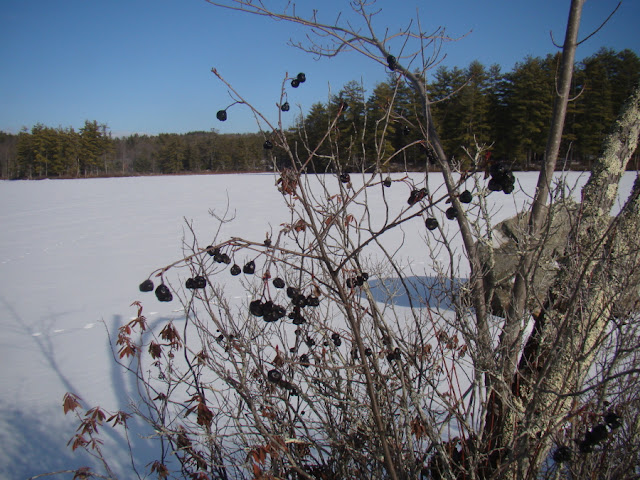January doesn't provide a lot of opportunities for plant observations because so many of them have closed up shop for the winter. Flowers are either dormant below the snow or have died and left only their seed behind, waiting for the encouragement of the spring sun to spur them back to life. The deciduous trees have cast off their leaves and sent all the energy they created over the summer down into their roots, also waiting for spring to warm the soil. But the bareness of January does divulge some secrets that are concealed or inaccessible - or both - when the lakes are alive with summer greenery. One such plant confessed its hidden beauty to me on a recent walk on the ice.
 |
| Tiny, spent blossoms of the leatherleaf. |
These plants are abundant in the marshes around Lake Wicwas, the dominant plant in fact of many bogs around the lake. I didn't immediately recognize it even though in the summer I'd seen it many times, it's pretty white flowers drawing my attention. Now in winter, those tiny blossoms, still clinging to the branches, once again caught my eye. Looking it up in the guide book reminded me it's leatherleaf.
 |
| Next year's buds are already in place. |
Here's the leatherleaf in its spring dress.
 |
| Leatherleaf in its May glory. |
Leatherleaf is classified as an evergreen (though it's leaves turn reddish-brown in winter). I should have recognized it!
On the same winter walk on the lake we came across another plant exposing it's secrets.
This fruiting shrub is growing on a tiny island in the lake, and is one I still haven't positively identified but my best guess is a variety of viburnum. It has large, dark berries that are not yet desiccated, but also not consumed by the birds.
Any suggestions?
Of course, in winter there are plenty of other trees that, like leatherleaf, keep their leaves all winter - pines, hemlocks, spruce, laurels, both mountain and sheep, and sometimes in winter the heat they absorb from the sun, combined with surrounding cold air, creates icicles as on these spruce trees in the Sandwich Range at an elevation of about 3000'.
 |
| Photo by Jim Lerner. |
With more snow and cold blustery weather, it's finally feeling like winter in New Hampshire!
 |
| An untracked trail leads up to Jennings Peak. |
 |
| Wind and snow add texture to the lake. |


No comments:
Post a Comment